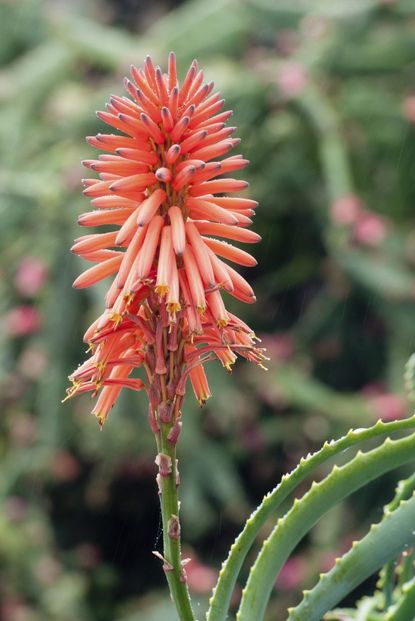Aloe Plant Blooms – Learn About Flowering Aloe Vera Plants


Aloe plants are commonly found in houses, apartments, offices, and other interior spaces. The aloe family is large and comprises of plants from an inch (2.5 cm.) tall up to 40 feet (12 m.) in height. While aloes begin life as small rosettes, resembling flowers, these are actually made up of leaves.
Does aloe bloom? Aloe flowers are not often formed in interior situations, but you can give the plant some special care and exposure to encourage blooming on mature plants. Read on for some tips for flowering aloe vera plants.
Does Aloe Vera Bloom?
There are over 400 species in the family aloe, with aloe vera one of the most popular forms. These easy to grow succulents tolerate a range of light neglect and thrive in well-draining, gritty soil, full sun, and regular water.
Aloe plant blooms rise from an inflorescence which soars above the attractive rosettes. Only mature plants of at least four years of age will bloom, so if you see no flowers on aloe plants, it may simply be due to the plant's age. It could also be due to cultural issues which are easily corrected and could result in your aloe presenting you with its lovely flowers.
As one of the most popular interior plants around, aloe vera is a unique succulent with a rosette form. Over time, smaller rosettes of leaves will form which can be pared away from the parent plant and grown individually. This type of common aloe flowers in March to May in USDA zones 7 to 9. In cooler climates, the plants exposure to heat and light may minimize its ability to produce flowers.
The inflorescences are reminiscent of Red Hot Poker plants, with tubular yellow and orange blooms dangling in a cluster atop a stiff flower stalk. Flowering aloe vera plants need the same cultural care as those not in bloom. Remove the spent flower stalk once all petals have dropped.
Encouraging Flowers on Aloe Plants
Flowers on aloe plants can be difficult to achieve when they are grown as houseplants. The many varieties produce a rainbow of hues dependent upon variety. Dense clusters of blooms open from the top down, giving a glimpse of both buds and fully formed flowers at the same time.
Gardening tips, videos, info and more delivered right to your inbox!
Sign up for the Gardening Know How newsletter today and receive a free download of our most popular eBook "How to Grow Delicious Tomatoes."
Aloe plants in full sun have the best chance of blooming, so you can move your plant outdoors once temperatures warm up in summer and no freezes are expected. The best temperatures for flowering are 70 to 85 degrees F. (21-29 C.) during the day and no lower than 60 degrees F. (15 C.) at night.
In spring, this means you many need to move the plant indoors for the evening. Ensure the soil mixture drains freely and water once per week in summer and about half the amount in winter.
Fertilizing Aloe Plants
Fertilizing your plant can help persuade aloe plant blooms. Use a balanced fertilizer in early spring and again in midsummer. Water after feeding to allow excess salts to drain out of the container. These can damage the delicate root system. Avoid using any of those high phosphorus or super phosphate formulas that promise blooms. The concentration of phosphorus can be damaging to the plant.
Transplant container specimens every two years to freshen the soil and aerate the roots. Small containers are the key to success. Provide the plant with only 1 to 1 ½ inches (2.5-4 cm.) of space at the edge of the pot. Aloes prefer tight living quarters and a dense root mass is most beneficial for a healthy plant with a chance at blooming.

Bonnie Grant is a professional landscaper with a Certification in Urban Gardening. She has been gardening and writing for 15 years. A former professional chef, she has a passion for edible landscaping.
-
 How To Grow Garden To Table: A Guide For Home Cooks
How To Grow Garden To Table: A Guide For Home CooksWhat could be better than a meal that comes directly from garden to table? Show off your gardening and culinary skills with the very freshest food.
By Bonnie L. Grant
-
 Want a Backyard Mini Orchard? Create Your Own Container Orchard
Want a Backyard Mini Orchard? Create Your Own Container OrchardEasier to care for in small spaces, a backyard mini-orchard makes sense for busy gardeners and juicy fruit is the reward.
By Teo Spengler